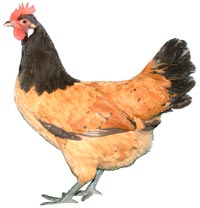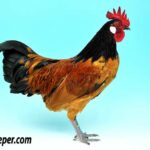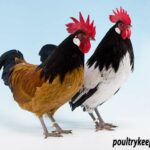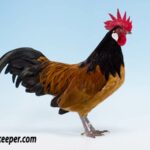
Uses: Attractive, economical utility birds.
Origin: Hamburg, Germany.
Eggs: 160 – 190 cream / tinted.
Weight: Cock: 2.5 – 3.2 Kg.Hen: 2.0 – 2.5 Kg.
Bantam Cock: 910 g. Hen: 680 g.
Colour: Black head, hackles and tail. Buff body and wings.
Useful to Know: Vorwerks are alert and active and generally docile, suitable for novices. They can fly reasonably well. Quick to mature and economical with food if allowed to forage, spare males can be used as a more ‘traditional’ table bird.
Photo: Vorwerk female. Courtesy of Rupert Stephenson.
Vorwerk chickens were developed in Hamburg, Germany by Oskar Vorwerk. In 1902 he set out to create a fowl that was more useful than the Lakenvelder, replacing the white with buff so it would not show the dirt and creating a bird for smallholders for utility: a bird that would provide a good number of eggs with a good feed to egg ratio as well as meat for the table when required.
The breeds used to develop the Vorwerk are thought to be the Lakenvelder, Utility Buff Orpington, Hittfeldern (now called Buff Ramelslohers in Germany), and the Andalusian. Oscar Vorwerk first exhibited his birds as new varieties in 1912 and by 1919 or a little earlier, they were well established and accepted by most breeders as an independent breed.
Vorwerk chickens first appeared in the UK as Buff Lakenvelders in 1935 where they were exhibited but it wasn’t until the 1970’s that they made a re-appearance.
Photos
Books
The following books are available. Links take you to the Amazon or other sellers’ pages for the books.
- Rare Poultry Breeds – D. Scrivener – P.74
- Storey’s Illustrated Guide to Poultry Breeds – C. Ekarius P.162 (Bantam only)
- British Poultry Standards – P.304
Breed Clubs
These are the breed clubs for Vorwerk chickens:











